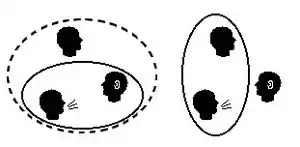包含式
包含式(clusivity)在語言學上是指介於包容性與排除'的第一人稱代詞及动词之間的語法區分,亦稱為包容性的「我們」及排除性的「我們」。包容性的「我們」具體包括「談話對象」(addressee)(意即,「我們」表示出「你和我」),而排除性的「我們」明確地排除「談話對象」(「我們」表示出「他/她/他們」及我,但不包括「你」),不管可能涉及任何其他人。同時想像這種區分卻可以在其他人稱(特別是第二人稱)直接表現出,事實上第二人稱包含式的存在(你、你們及他們)在自然語言是有爭議的,並沒有得到很好的證明。[1]
第一人稱包含式在达罗毗荼语系、澳大利亚原住民语言,及南島語系中是一個共同的特點,而且還發現存在東亞、南亞、西南亞、美洲的語言,及在一些克里奧爾語裡。閩南語語法也有這種區別,分別用「咱」(包含)和「阮」(不包含)兩個不同的代詞表示。一些非洲語言也有這種區別,比如富拉語。高加索以外的任何歐洲語系沒有這種語法的區分,但某些結構上可能在语义学上存有包含式或排除式等內涵。
範式示意圖

參考集合表示:包含式的形式(左)及和排除式的形式(右).
包含式範例可以被歸納為一個二乘二的表格:
| 包含談話的對象嗎? | |||
|---|---|---|---|
| 是 | 不是 | ||
| 包含 說話者嗎? |
是 | 包含式 我們 (咱們) | 排除式 我/我們 |
| 不是 | 你/你們 | 他們 | |
形態學
在某些語言裡,這三個第一人稱代詞看來無關。
動詞區別
例如,在馬拉賽-帕薩馬闊地語(Malecite-Passamaquoddy language)"我/我們有它(I/we have it)"表示:
- Singular n-tíhin (第1人稱前綴 n-)
- Exclusive n-tíhin-èn (第1人稱 n- + 複數後綴 -èn)
- Inclusive k-tíhin-èn (排除式前綴 k- + 複數 -èn)
註釋
- Simon, Horst J. Only you? Philological investigations into the alleged inclusive-exclusive distinction in the second person plural, in: Elena Filimonova (ed.): Clusivity: Typology and case studies of the inclusive-exclusive distinction. Amsterdam/Philadelphia 2005. (PDF). [2010-08-02]. (原始内容 (PDF)存档于2011-06-09).
參見
- We
- 排除式(Exclusivity)
延伸閱讀
- Jim Chen, First Person Plural (analyzing the significance of inclusive and exclusive we in constitutional interpretation)
- Payne, Thomas E., , Cambridge University Press, 1997, ISBN 0-521-58224-5
- Filimonova, Elena (eds). (2005). Clusivity: Typological and case studies of the inclusive-exclusive distinction. Amsterdam: John Benjamins Publishing Company. ISBN 90-272-2974-0.
This article is issued from Wikipedia. The text is licensed under Creative Commons - Attribution - Sharealike. Additional terms may apply for the media files.